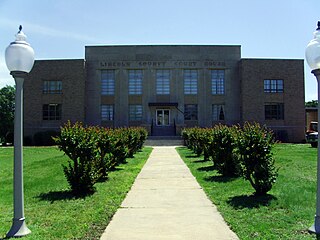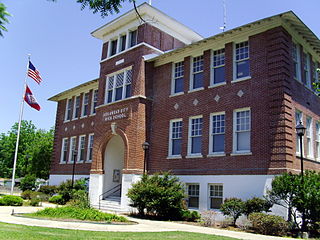Related Research Articles

Lincoln County is located between the Arkansas Timberlands and Arkansas Delta in the U.S. state of Arkansas. It is situated just outside the outer edge of the Central Arkansas metropolitan region. The county is named for President Abraham Lincoln. Created as Arkansas's 65th county on March 28, 1871, Lincoln County has three incorporated cities, including Star City, the county seat and most populous city. The county contains 46 unincorporated communities and ghost towns, Cane Creek State Park at the confluence of Cane Creek and Bayou Bartholomew, and nine listings on the National Register of Historic Places to preserve the history and culture of the county.

Gould is a city in Lincoln County, Arkansas, United States. Its population was 663 at the 2020 census, down from 837 at the 2010 census. It is included in the Pine Bluff, Arkansas Metropolitan Statistical Area. Gould is a farming community. It was named after the American railroad magnate Jay Gould.

Grady is a city in Lincoln County, Arkansas, United States. The population was 305 at the 2020 census, down from 449 at the 2010 census. It is included in the Pine Bluff, Arkansas Metropolitan Statistical Area.

The Cummins Unit is an Arkansas Department of Corrections prison in unincorporated Lincoln County, Arkansas, United States, in the Arkansas Delta region. It is located along U.S. Route 65, near Grady, Gould, and Varner, 28 miles (45 km) south of Pine Bluff, and 60 miles (97 km) southeast of Little Rock.
Pine Bluff School District No. 3 (PBSD) is a school district headquartered in Pine Bluff, Arkansas. The district has 10 schools with over 3,800 students and 500 employees.
The Sunflower County Consolidated School District (SCCSD), formerly the Sunflower County School District (SCSD), is a public school district with its headquarters in Indianola, Mississippi in the Mississippi Delta. The district serves all of Sunflower County.
Dollarway School District No. 2 (DSD) was a school district headquartered in Pine Bluff, Arkansas, United States. With over 1,600 students and employing more than 300 educators and staff, the district had three active school campuses at the end of its life.

Tucker is an Unincorporated community and census-designated place (CDP) in Jefferson County, Arkansas. It is located 30 miles (48 km) southeast of Little Rock. It was first listed as a CDP in the 2020 census with a population of 95.
Grady Public Schools was a school district with its headquarters in Grady, Arkansas. Its territory is now within the Star City School District.
Star City School District is a public school district headquartered in Star City, Arkansas, United States. The district serves Star City and Grady as well as multiple unincorporated areas.
Dumas Public Schools is a school district headquartered in Dumas, Arkansas. It serves territory in Desha and Lincoln counties, including Dumas, Gould, Mitchellville, and Winchester. It also serves Arkansas Department of Corrections prison property.

The Arkansas City School District was a school district of Arkansas City, Arkansas. Its territory is now in the McGehee School District.
The Delta Special School District was a school district of Rohwer, unincorporated Desha County, Arkansas, USA. Its territory is now in the McGehee School District. It also included Watson.
Dollarway High School was a comprehensive public high school in northwest Pine Bluff, Arkansas that served grades 9 through 12. It was one of three public high schools in Pine Bluff and was a part of the Pine Bluff School District effective July 1, 2021. Prior to that point it was the only high school managed by the Dollarway School District. Within the state, the school is often referred to as Pine Bluff Dollarway. It closed as of fall 2023.

Star City High School is a comprehensive public high school for students in grades 9 through 12 located in Star City, Arkansas, United States. Star City High School is the only public high school in Lincoln County and the only high school of the Star City School District.
Dumas High School (DHS), formerly Dumas New Tech High School, is a comprehensive public secondary school located in Dumas, Arkansas, United States, for students in grades ten through twelve. Dumas is one of two public high schools in Desha County and is the sole high school administered by the Dumas School District.
Emerson–Taylor-Bradley School District (ETBSD) is a public school district headquartered in Taylor, Arkansas, United States. The school district supports more than 950 students in prekindergarten through grade 12 in the 2015-2016 school year by employing more than 250 faculty and staff on a full time equivalent basis for its six schools.
Norphlet School District 50 was a school district in Norphlet, Union County, Arkansas, United States. The district had more than 400 students in prekindergarten through grade 12 and employed more than 75 teachers and staff for its two schools and district offices.
Smackover-Norphlet School District No. 39 (SNSD), formerly Smackover School District 39, is a school district based in Smackover, Arkansas. It has territory in Union County, Ouachita County, and Columbia County.
Stephens School District 13 was a school district in headquartered in Stephens, Arkansas, serving sections of Ouachita, Columbia, and Nevada counties. It served Stephens and McNeil.
References
- ↑ "Arkansas Department of Education school district maps, 1952-1954 Lincoln County, 1952-1954". Arkansas Digital Archives. Arkansas State Archives. (Download) - See "Cummins State Convict Farm"
- 1 2 3 "History" (). Gould School District. Retrieved on March 6, 2011.
- ↑ "Lincoln County." Encyclopedia of Arkansas (Central Arkansas Library System). Last updated December 31, 2010. Retrieved on March 8, 2011.
- ↑ "History And Description Of The Arkansas Correctional School Archived 2011-07-21 at the Wayback Machine ." Arkansas Correctional School. Retrieved on March 7, 2011.
- 1 2 "Arkansas black school district ends liberal transfer policy." Associated Press at the Bangor Daily News . AM Line Weekend. Saturday-Sunday January 19–20, 1991. 19. Retrieved from Google News (114 of 187) on March 8, 2011.
- 1 2 3 4 "Dumas inherits Gould district’s deficit." () Arkansas News. May 11, 2005. Retrieved on March 7, 2011.
- ↑ "A MEETING OF THE BOARD OF EDUCATION OF THE GOULD SCHOOL DISTRICT." (Archive) Gould School District. Retrieved on March 6, 2011.
- 1 2 3 4 "Board approves more consolidations." () Arkansas News . May 18, 2004. Retrieved on March 7, 2011.
- ↑ "Consolidation/Annexations of LEA's (1983-2010) [usurped] ." Arkansas Department of Education. Retrieved on March 6, 2011.
- ↑ "2002-2003 Arkansas Education Directory." Arkansas Department of Education. 68-69 (74-75/157). Retrieved on March 6, 2011.
- ↑ "2003-2004 Student Handbook." (Archive) Gould School District. 11 (11/42). Retrieved on March 7, 2011.
- ↑ "2003-2004 Student Handbook." (Archive) Gould School District. 12 (12/42). Retrieved on March 7, 2011.